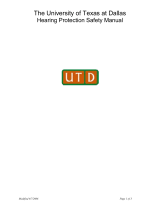
Response:
A number of design parameters affect
the performance of the foam earplugs.
The most important of these are the re-
covery characteristics of the foam and
its stiffness. These properties should be
optimized for best performance, and be
relatively independent of humidity and
temperature. If a plug expands too rap-
idly or is too soft it may be difficult or
impossible to insert. Conversely, if it ex-
pands too slowly it may dislodge before
fully seating, and if it is too stiff it will be
less comfortable to wear.
A principal feature affecting the above
properties is the material from which the
plug is made, typically polyvinyl chloride
(PVC) or polyurethane (PU). PVC is
generally preferred because of stability.
PU plugs tend to rapidly absorb mois-
ture when stored in high humidity con-
ditions or are exposed to excessive per-
spiration. This can dramatically speed
their expansion, degrading one's ability
to properly insert the plugs for optimum
comfort and attenuation.
Question:
Can I use noise reducing earplugs for
swimming?
Response:
Yes. Certain noise reducing earplugs
such as those made from vinyl, closed-
Question:
Can I use cotton or my fingers to
reduce harmful noise exposures?
Response:
Occasionally one finds persons wearing
nonstandard HPDs such as gum, putty,
cotton, cigarette filters, empty bullet cas-
ings and other items which will not ad-
equately seal the ear canal or simply do
not possess the needed physical char-
acteristics to effectively attenuate sound.
Additionally, such devices are often un-
comfortable and unhygienic. For ex-
ample, ordinary dry cotton is a very poor
hearing protector as shown in Figure 2.
Interestingly, a finger tip, although it cer-
tainly cannot be utilized for extended
periods of time, does provide very good
protection (see Figure 2) when forced
tightly into the ear canal.
Comment:
My mother always said “never put any-
thing smaller than your elbow in your ear.”
Response:
This platitude is representative of the
numerous preconceptions and miscon-
ceptions that many people have regard-
ing the use of HPDs. Of course when
mother delivered the above pronounce-
ment she had in mind the pencils, pins,
toothpicks, and clumsily maneuvered
Q-tips
®
that could damage the delicate
eardrum, or other miscellaneous objects
that might become lodged in the ear ca-
nal. Unfortunately, she was not aware of
the lasting negative mental imprint that
this would create with regard to the safe
and correct use of properly designed and
fitted noise reducing earplugs (c.f.
EARLog #9
1
, Question 7). In order to
overcome such notions it will frequently
be necessary for a trainer to correctly
insert earplugs for the employee at least
one time during an instructional session,
so the employee can experience the sen-
sation of a correctly inserted earplug
placed well into the ear canal. Often, fit-
ting one of the employee’s ears, and then
asking him to fit the other so both ears
“feel the same,” is a helpful technique.
Conclusion
The material reviewed in this and the pre-
ceding two EARLogs can provide a ba-
sis for formulating either verbal or writ-
ten responses (newsletters, bulletins,
pamphlets) to questions and complaints
regarding hearing protection and hear-
ing conservation. We have reviewed the
more common, and in our opinion the
more significant issues that may be
raised, but other concerns certainly ex-
ist. We invite you to address additional
questions to us so that we may assist
you, and perhaps include the information
in future EARLogs. Letters should be sent
to Mr. Berger at the address shown be-
low.
References and Footnotes
E•A•RLog® is a registered trademark of Aearo Company. Copyright 1996. First printing 1983.
LIT. CODE 30302 2/99 AG
ATTENUATION OF TWO NONSTANDARD
HEARING PROTECTORS COMPARED TO
A TYPICAL EARPLUG
TYPICAL EARPLUG*
DRY COTTON
9
FINGERTIP
10
FREQUENCY (kHz)
Figure 2
REAL-EAR ATTENUATION (dB)
* Average data from 16 earplugs measured according to
ANSI S3.19 in the E•A•RCAL
SM
Laboratory.
.125
50
30
40
20
10
0
.250 .500 1.0 2.0 3.15 4.0 6.3 8.0
cell foam, silicone, and even wax-impreg-
nated cotton can be successfully used
in many cases for swimming and show-
ering
6,7,8
. In fact they will generally per-
form better than the plugs that are sold
over-the-counter as “swimmer’s plugs”
since they fit the ear canal more com-
fortably and snugly. The plugs should be
inserted in a dry condition, before enter-
ing the water, and the user should not
submerge his head more than a few feet
below the surface since this increases
the likelihood of water being forced
around the plug.
Berger, E. H. The EARLog complete series is avail-
able upon request from Aearo Company.
American National Standards Institute (1977). “For
Rating Noise with Respect to Speech Interference,”
S3. 14-1977, New York, NY.
Tonndorf, J. (1972). “Bone Conduction,” in
Foun-
dations of Modern Auditory Theory, Vol. II
, edited
by J. V. Tobias, Academic Press, New York, NY,
195-238.
Berger, E. H. and Kerivan, J. E. (1982). “A Rigor-
ous Examination of the Real-Ear Attenuation at
Threshold Method (125 Hz-2 kHz),” J. Acoust. Soc.
Am. 70, Suppl. 1, S52.
Gardner, R. Jr. (1977).”Earplugs,”U.S. Patent No.
Re. 29,487. E-A-R
®
brand earplugs are manufac-
tured in conformance with this patent.
Johnson, D. W., Mathog, R. H. and Maisel, R. H.
(1977). Tympanostomy Tube Protection with Ear
Plugs,” Arch. Otolaryngol. 103(7), 377-380.
Johnson, D. W. and Maisel, R. H. (1981). “Objec-
tive Evaluation of Earplugs for the Control of Wa-
ter-Borne Infection,” Ann. Otolaryngol. 90, 89-93
Brandell, M. E. and Seestedt, L. (1978). “Report
on the Effectiveness of E-A-R
®
Plugs as Ear Pro-
tection in Water,” Central Michigan Univ., Mt. Pleas-
ant, MI.
Tobias, J. V. (1975). “Earplug Rankings Based on
the Protector-Attenuation Rating (P-AR),” FAA Civil
Aeromed. Inst. Report FAA-AM-75-11, Oklahoma
City, OK.
Holland, H. H., Jr. ( 1967) “Attenuation Provided
by Fingers, Palms, Tragi, and V51R Ear Plugs,”
Letter to the Editor, J. Acoust. Soc. Am. 41(6), 1545.
1.
2.
3.
4.
5.
6.
7.
8.
9.
10.




